Book notes: Thinking in Systems.
Book notes on "Thinking in Systems" by Donella H. Meadows

These are my notes on Thinking in Systems by Donella H. Meadows.
The book covers the basic of Systems Thinking.
Key Insights
- The system response to an external stimulus is a characteristic of the system itself.
- The purpose of a system is the most crucial determinant of the system’s behaviour.
- Changes on purpose are the most drastic.

- Changes on purpose are the most drastic.
- Stocks:
- Are the elements of the system that you can see, feel, count, or measure at any given time.
- Act as delays, buffers or shock absorbers in systems.
- Allows inflows and outflows to be independent and decoupled and temporarily out of balance with each other.
- Flows can change suddenly.
- The human mind focus more easily on stocks than on flows, and more on inflows than outflows.
- Feedback loops: Balancing vs Reinforcing.
- Information delivered by a feedback loop can only affect future behaviour.
- There is always a delay.
If A cause B, is it possible that B also causes A?
- System studies are not designed to predict what will happen. They are designed to explore what would happen if a number of driving factors unfold in a range of different ways.
- Delays are pervasive in systems, and they are strong determinants of behaviour.
- Structures:
- Self-Organization:
- Produces heterogeneity and unpredictability.
- Requires freedom, experimentation and unpredictability.
- Threat to power structures.
- Hierarchy:
- Give systems stability, resilience and reduce cognitive load in the subsystems.
- The original purpose is always to help its original subsystems do their job better.
- Resilience and self-organization are often sacrificed for short-term productivity and stability.
- Self-Organization:
- Our knowledge is amazing; our ignorance even more so.
- We are fascinated by the events generated, and we pay too little attention to their history.
- The greatest complexities arise exactly at the boundaries of systems.
- Boundaries are of our own making, and should be reconsidered for each new discussion, problem or purpose.
- The most important input to a system is the one that is most limiting.
- For systems to work well, the right feedback must get to the right place at the right time.
- Change comes from enlargement of bounded rationality, by providing better, more complete, timelier information.
- System traps:
- Drift to low performance:
- Allow performance standards to be influenced by past performance, specially negative perceived performance, creating a reinforcing feedback loop of eroding goals.
- Keep performance absolute.
- Allow performance standards to be influenced by past performance, specially negative perceived performance, creating a reinforcing feedback loop of eroding goals.
- Success to the successful - Competitive Exclusion:
- Winners are systematically reworded with means to win again, a reinforcing loop, where winners will eventually take all.
- Shifting the burden to the intervenor:
- Intervention erodes the self-maintaining capacity of the system, which requires more intervention, creating a destructive reinforcing loop.
- Seeking the wrong goal:
- Define outcomes, not outputs.
- Drift to low performance:
- People deeply involved in a system often know intuitively where to find leverage points, but often they push the change in the wrong direction.
- Systems can’t be controlled, but they can be designed and redesigned.
- Before you disturb system, watch how it behaves.
- Start by focusing on the historical facts.
- Pay attention to what is important, not just what is quantifiable.
- The universe spends its time in transient behaviour on its way to something else.
TOC
- Introduction
- Part 1 - System Structure and Behaviour
- Part 2 - Systems and Us
- Part 3 - Creating Change in Systems and in Our Philosophy
Introduction
- A system is a set of thing interconnected in such a way that they produce their own pattern of behaviour over time.
- The system response to an external stimulus is a characteristic of the system itself, and that response is seldom simple in the real world.
- Hunger, poverty, environmental degradation, … are intrinsically system problems: stop casting blame, see the system as the source of its own problems, and find the courage and wisdom to restructure the system.
Part 1 - System Structure and Behaviour
Chapter 1 - The Basics
- Systems consist of:
- Elements.
- Interconnections.
- Function or purpose.
- The least obvious.
- Most crucial determinant of the system’s behaviour.
- One of the most frustrating aspects of systems is that the purposes of subunits may add up to an overall behaviour that no one wants.
- Relative importance:
- Changing elements has the least effect.
- Changing interconnections may alter the system greatly.
- Changes on purpose are drastic.
- Changing an element is the less noticeable, unless it also changes interconnections or purpose.
- Stocks:
- Are the elements of the system that you can see, feel, count, or measure at any given time.
- Change over time through the actions of flow.
- Take time to change, because flows take time to flow:
- Act as delays, buffers or shock absorbers in systems.
- Allows inflows and outflows to be independent and decoupled and temporarily out of balance with each other.

- Flows can change suddenly.
- The human mind focus more easily on stocks than on flows, and more on inflows than outflows.
- All system diagrams are simplifications of the real world.
- Feedback loops:
- When changes in a stock affect the flows into or out of that same stock.
- Balancing feedback loop:
- Goal-seeking or stability-seeking.
- Tries to keep a stock at a given value or within a range of values.
- It may not work well or be strong enough.
- Tagged as “B” in system diagrams.
- Reinforcing feedback loop:
- Generates more input to a stock the more stock there is already there.
- A vicious or virtuous cycle.
- Whenever a stock has the capacity to reinforce or reproduce itself.
- Tagged as “B” in system diagrams.
If A cause B, is it possible that B also causes A?
Chapter 2 - Brief visit to the Systems Zoo
- Information delivered by a feedback loop can only affect future behaviour.
- There is always a delay.
- Delay and current state of flows should be taken into account in the balancing feedback loop.
- Dominance: when one feedback loop dominates another, it has a strong impact on behaviour.
- System studies are not designed to predict what will happen. They are designed to explore what would happen if a number of driving factors unfold in a range of different ways.
- Questions for testing the value of a model:
- Are the driving factors likely to unfold this way?
- Speculative answer.
- If they did, would the system react this way?
- Scientific answer.
- What is driving the driving factors?
- System boundaries: are they independent or embedded within the system?
- Are the driving factors likely to unfold this way?
- Systems with similar feedback structures produce similar dynamic behaviours, even if the outward appearance is completely dissimilar.
- A delay in a balancing feedback loop makes a system likely to oscillate.
- Delays are pervasive in systems, and they are strong determinants of behaviour.
- Changing the length of a delay may make a large change in the behaviour of a system.
- The trick is to recognize what structures contain which latent behaviours, and what conditions release those behaviours, and arrange the structures and conditions to encourage the beneficial ones.
- Zoo:
- A stock with two competing balancing loops - A thermostat
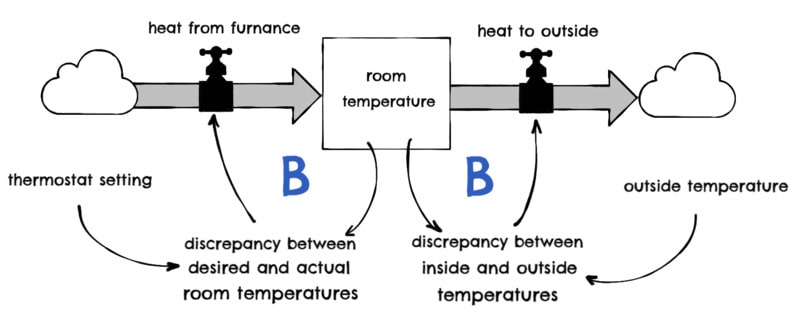
- A stock with one reinforcing loop and one balancing loop - Population and Industrial Economy

- A system with delays - Business Inventory
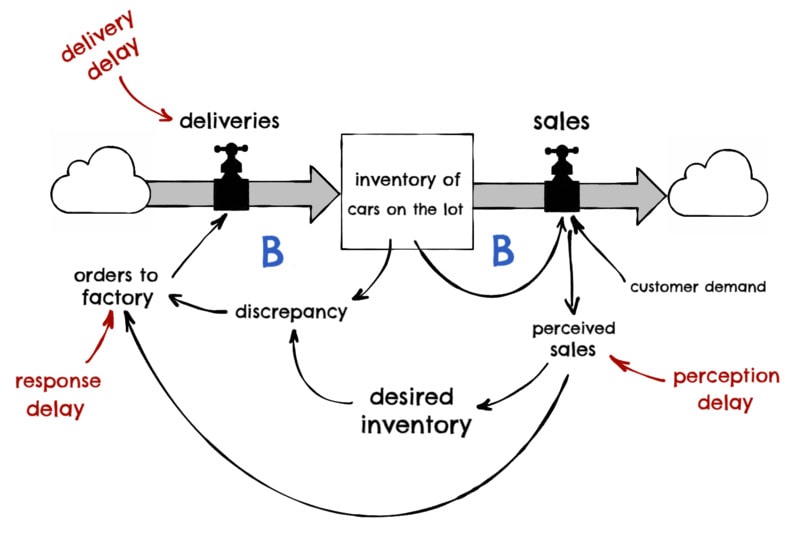
- Oscillation if delay is too short:
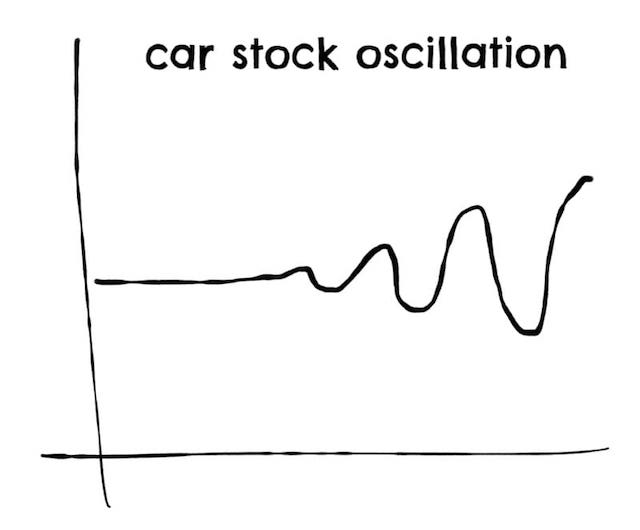
- Oscillation if delay is too short:
- A renewable stock constrained by a non-renewable stock - an oil economy:
- Constraints take the form of a balancing loop that will shift the dominance of the reinforcing growth loop, by strengthening the out flow or weakening the inflow.
- The higher and faster you grow, the farther and faster you fall, when you are building up a capital stock dependant on a nonrenewable resource.
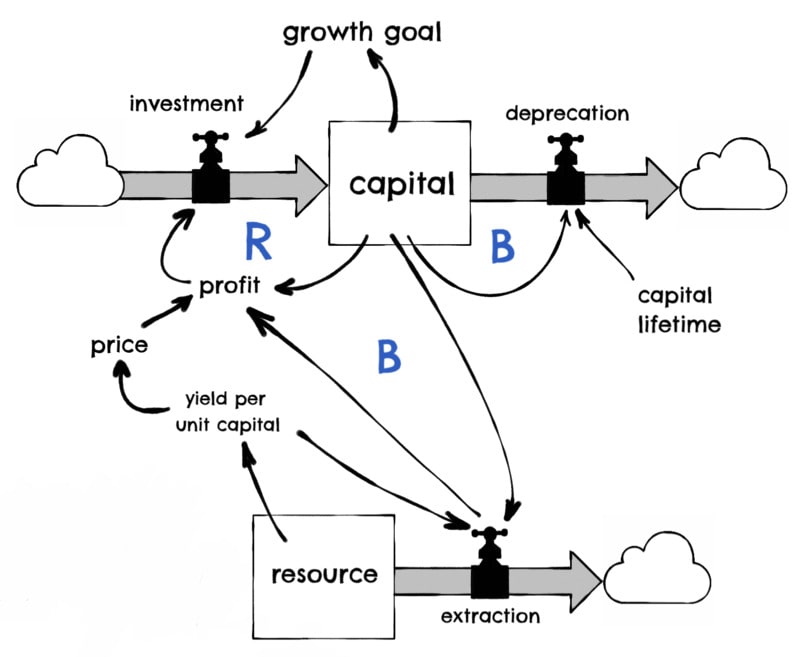
- Renewable stock constrained by a renewable stock - a fish economy
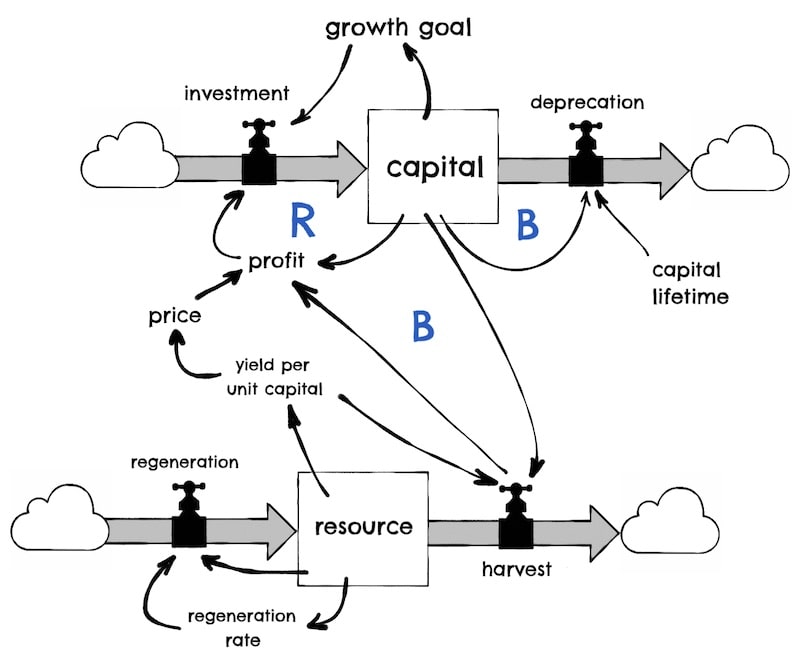
- 3 scenarios:
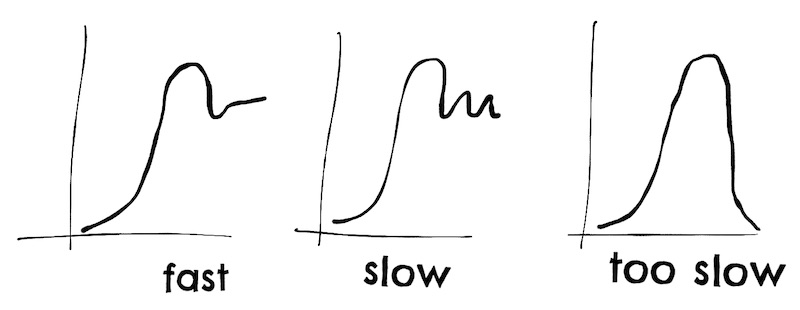
- Depends on:
- Critical threshold beyond which the renewable stock cannot reproduce itself.
- Speed of balancing feedback loop that slows capital growth:
- Fast: equilibrium.
- Slow: oscillation.
- Too slow: collapse.
- 3 scenarios:
- A stock with two competing balancing loops - A thermostat
Part 2 - Systems and Us
Chapter 3 - Why systems work so well
- Why?
- Resilience: it can be managed, enhanced.
- Self-Organization:
- Capacity of a system to make its own structure more complex.
- Fundamental to living systems.
- Produces heterogeneity and unpredictability.
- Requires freedom, experimentation and unpredictability.
- Threat to power structures.
- Hierarchy:
- Give systems stability, resilience and reduce cognitive load in the subsystems.
- Relationship within a subsystem are stronger than across subsystems.
- The original purpose is always to help its original subsystems do their job better.
- Possible issues:
- Sub-optimization.
- Too much centralization.
- Resilience and self-organization are often sacrificed for short-term productivity and stability.
Chapter 4 - Why Systems Surprise Us
- Our knowledge is amazing; our ignorance even more so.
- Everything we know about the world is a model, that are congruent but always fall short, causing mistakes and surprises.
- Beguiling Events:
- We are fascinated by the events generated, and we pay too little attention to their history.
- The behaviour of a system is its performance over time, revealing itself as a series of events.
- System structure is the source of system behaviour.
- Nonlinear Relationships:
- Produce unexpected shifts in feedback loops.
- Spruce Budworms example.
- Nonexistent Boundaries:
- The greatest complexities arise exactly at the boundaries.
- There is no single, legitimate boundary to draw around a system.
- There are no separate systems. The world is a continuum.
- Too narrow boundaries == surprises.
- System analysts often make boundaries too large.
- Correct boundaries depends on the problem analyzed.
- Boundaries are of our own making, and should be reconsidered for each new discussion, problem or purpose.
- Layers of limits:
- The most important input to a system is the one that is most limiting.
- Surprised because we have limited cognitive capacity to understand that multiple inputs produce multiple outputs. So it is not 1 cause == 1 effect, but multiple causes == multiple effects.
- Growth itself depletes or enhances limits, hence changes what is limiting.
- There be always limits to growth, either self-imposed or system-imposed.
- Ubiquitous Delays:
- We are surprised how much time things take.
- Overshoots, oscillations, and collapses are always caused by delays.
- To act only when a problem becomes obvious is to miss an important opportunity to solve the problem.
- Bounded Rationality:
- From Nobel Prize Herbert Simon:
- People make reasonable decisions based on the information they have, but they do not have perfect information, specially from more distant parts of the system.
- We also misinterpret the information that we have.
- Change comes from enlargement of bounded rationality, by providing better, more complete, timelier information.
- Stanford prison experiment by Philip Zimbardo.
- For systems to work well, the right feedback must get to the right place at the right time.
- From Nobel Prize Herbert Simon:
Chapter 5 - System Traps … and Opportunities
- Archetypical problem-generating structures.
- Policy resistance system:
- Various actors pull the system stock towards various goals. The more an actor pulls, the more the other actors need to pull, with everybody expending considerable effort in maintaining a result that nobody likes.
- Example: war on drugs.
- The way out: Let go.
- Align actors to a larger and more important goal.
- Actors to agree and to seek out mutually satisfactory ways for all goals to be realized.
- The tragedy of the Commons:
- Commonly shared erodible resource, that every user benefits directly from, but cost of its abuse are shared by everybody.
- Weak feedback from the condition of the shared resource and its users.
- Overuse, erosion, destruction.
- The way out:
- Education and extortion.
- Privatization to strength the feedback loop.
- Regulation of use.
- Drift to low performance:
- Allow performance standards to be influenced by past performance, specially negative perceived performance, creating a reinforcing feedback loop of eroding goals.
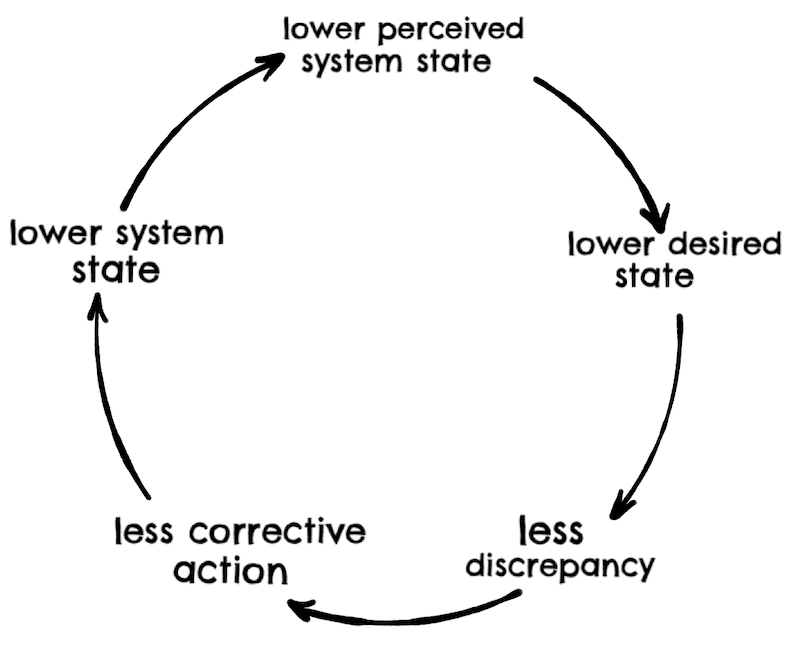
- The way out:
- Keep performance absolute.
- Make goals sensitive to best historical performance.
- Allow performance standards to be influenced by past performance, specially negative perceived performance, creating a reinforcing feedback loop of eroding goals.
- Escalation:
- The state of one stock is determined by trying to surpass the state of another stock – and viceversa – creating a reinforcing feedback loop.
- Example: Arms.
- Way out:
- Refuse to compete.
- Negotiate a new system with balancing loops.
- Success to the successful - Competitive Exclusion:
- Winners are systematically reworded with means to win again, a reinforcing loop, where winners will eventually take all.
- Way out:
- Diversification
- Limitation on how much the winner can win (antitrust laws).
- Policies that level the playing field.
- Policies that reward for success that not bias the next round of competition.
- Shifting the burden to the intervenor:
- Intervention reduces the symptoms, but do not address the underlying problem.
- Intervention erodes the self-maintaining capacity of the system, which requires more intervention, creating a destructive reinforcing loop.
- Example: addiction.
- Way out:
- Avoid getting in by strengthening the ability of the system to shoulder its own burdens.
- Take focus off short-term relief to long-term restructuring.
- Rule beating:
- Perverse behaviour that gives appearance of obeying the rules but actually distorts the system.
- Way out:
- Design rules to release to release creativity not in the direction of beating the rules, but in the direction of achieving the purpose of the rules.
- Seeking the wrong goal:
- Goals defined inaccurately, may produce results that are not really wanted.
- Way out:
- Define outcomes, not outputs.
Part 3 - Creating Change in Systems and in Our Philosophy
Chapter 6 - Leverage Points - Places to Intervene in a System
- People deeply involved in a system often know intuitively where to find leverage points, but often they push the change in the wrong direction.
- Complex systems are counter-intuitive.
- List of leverage points, from less leverage to most leverage:
- Numbers - Constants and parameters such as subsidies, taxes, standards.
- Little leverage, unless the parameter goes into a range that kick off one of the other leverages on this list.
- They get too much attention as they are short-term.
- Buffers - The sizes of stabilizing stocks relative to their flows.
- Not high leverage as changing the size of buffers is usually hard and costly.
- Stocks-and-Flow Structures - Physical systems and their nodes of intersection.
- The leverage point is proper design in the first place, as rebuilding is slow and expensive.
- Delays - the lengths of the time relative to the rates of system changes.
- Not higher in list because often they are not easy to change.
- Balancing Feedback Loop - The strength of the feedback relative to the impacts they are trying to correct.
- More leverage on information and control than the physical part.
- We understanding the importance of feedback loops that are seldom used, like emergency mechanism.
- Encroaching on our own time for personal rest, recreation, socialization, and meditation.
- Reinforcing feedback loops - the strength of the gain of driving loops.
- A system with an unchecked reinforcing loop ultimately will destroy itself.
- Reducing the gain around a reinforcing loop – slowing the growth – is usually a more powerful leverage point than strengthening balancing loops.
- Information flows - the structure of who does and does not have access to information.
- Missing information flows is one of the most common causes of system malfunction.
- Missing feedback loops are due to humans avoiding accountability.
- Leverage point popular with masses and unpopular with the powers.
- Rules - Incentives, punishments, constraints.
- If you want to understand the deepest malfunctions of systems, pay attention to the rules and to who has power over them.
- Self-Organization - the power to add, change, or evolve structure.
- In biological systems is called evolution.
- The ability to self-organize is the strongest form of system resilience.
- Rules of self-organization.
- Self-organization == evolutionary raw material + experimentation.
- Leverage unpopular point: encourage variability and experimentation.
- Goals - the purpose or function of the system.
- People within system don’t often recognize what whole-system goal they are serving.
- Paradigms - the mind-set out of which the system - its goal, structure, rules, delays, parameters - arises.
- Paradigms are the sources of systems.
- There is nothing physical or expensive or even slow in the process of paradigm change.
- But whole societies resist paradigm changes harder than anything else.
- How to change paradigms? (Thomas Kuhn):
- Keep pointing anomalies and failures of current paradigm.
- Keep speaking and acting, loudly and with assurance from the new one.
- Insert people with the new paradigm in places of public visibility and power.
- Ignore reactionaries.
- Focus on active change agents and with open-minded people.
- Building a system model forces us to see it whole.
- Transcending paradigms.
- Realizing that no paradigm is “true”, hence chase the one that will help to achieve your purpose.
- Numbers - Constants and parameters such as subsidies, taxes, standards.
- Mastery has less to do with pushing leverage point than it does with strategically, profoundly, madly, letting go and dancing with the system.
Chapter 7 - Living in a World of Systems
- One thing is to understand how to fix a system, quite another to wade in and fix it.
- Systems can’t be controlled, but they can be designed and redesigned.
- There is always going to be uncertainly.
- Get the beat of the system:
- Before you disturb system, watch how it behaves.
- Start by focusing on the historical facts.
- Expose your mental models to the light of day:
- Write them down to clarify your thoughts.
- Get feedback.
- Honor, respect and distribute information:
- Information is power.
- Use language with care and enrich it with system concepts.
- Pay attention to what is important, not just what is quantifiable.
- Make feedback policies for feedback system:
- Especially where there are great uncertainties, the best policies not only contain feedback loops, but meta-feedback loops - loops that alter, correct, and expand loops. These adds learning into the management process.
- Go for the good of the whole.
- Listen to the wisdom of the system:
- Before you charge in to make things better, pay attention to the value of what is already there.
- Locate responsibility in the system.
- Stay humble, stay a learner.
- Celebrate complexity:
- The universe spends its time in transient behaviour on its way to something else.
- Expand time horizons:
- Don’t focus solely in short-term.
- Defy the disciplines:
- Seeing systems whole requires more the being “interdisciplinary”.
- Admit ignorance and be willing to be taught, by each other and by the system.
- Expand the boundary of caring.
- Don’t erode the goal of goodness:
- Modern industrial culture has eroded the goal of morality. We are in a “drift to low performance” archetype.